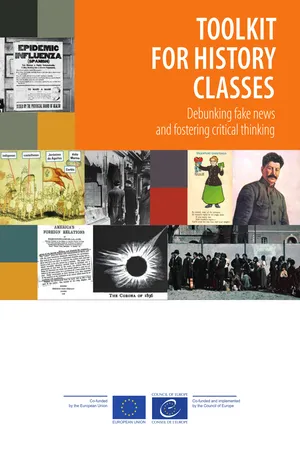
Toolkit for history classes
Debunking fake news and fostering critical thinking
- English
- ePUB (mobile friendly)
- Available on iOS & Android
Toolkit for history classes
Debunking fake news and fostering critical thinking
About this book
In a saturated and complex workd of information, how can students be helped to seek, evaluate and verify information?
Over the past two decades, the use of the internet and social media has enabled wider and faster access to information around the world. In doing so, however, it has also opened the door to misinformation, manipulation, fake news and political propaganda. Every industry, institution and individual person has had to adapt to this influx of unreliable information, and many organisations have begun to adopt new policies and issue recommendations on how to manage this new way of life.
The publication Toolkit for history classes – Debunking fake news and fostering critical thinkin g is a co-ordinated response by the European Union and Council of Europe to this phenomenon. The toolkit is a resource for history teachers to help their students learn how to deconstruct and question fake news through historical sources and topics that relate the past to the present. The toolkit aligns with the values and priorities of the European Union and Council of Europe, as both institutions have worked for many years to draw attention to the dangers caused by disinformation and the manipulation of history.
The toolkit was designed for teachers to show students not only how to recognise fake news when they see it, but also understand why it was created and become aware of the minority communities who are most often the target of this manipulated information.
Frequently asked questions
- Essential is ideal for learners and professionals who enjoy exploring a wide range of subjects. Access the Essential Library with 800,000+ trusted titles and best-sellers across business, personal growth, and the humanities. Includes unlimited reading time and Standard Read Aloud voice.
- Complete: Perfect for advanced learners and researchers needing full, unrestricted access. Unlock 1.4M+ books across hundreds of subjects, including academic and specialized titles. The Complete Plan also includes advanced features like Premium Read Aloud and Research Assistant.
Please note we cannot support devices running on iOS 13 and Android 7 or earlier. Learn more about using the app.
Information
Table of contents
- Cover
- Title page
- Contents
- Chapter 1. Introduction
- Part I. THE TOOLKIT
- Part II. THEORETICAL FRAMEWORK AND METHODOLOGY
- Part III. REFERENCES
- Copyright
- Table of contents